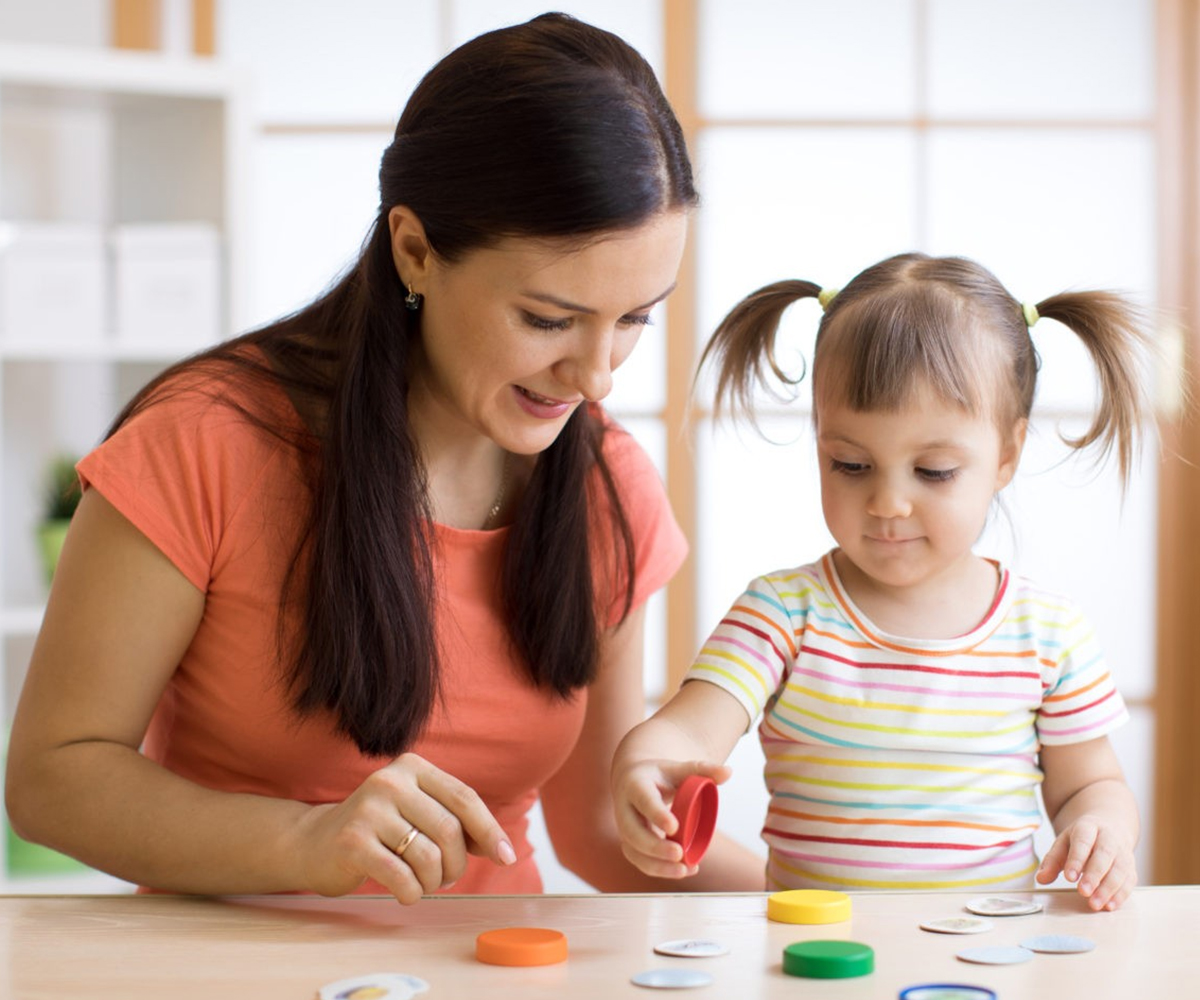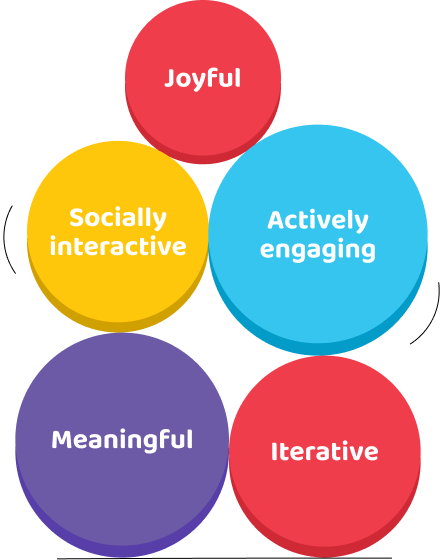

WHAT WE DO
Characteristics of Playful Learning Experiences
We use these five characteristics to highlight playful experiences as learning contexts. The five characteristics ebb and flow as children are engaged in learning through play and all five are not necessary all the time.
But over time, children should experience moments of joy and surprise, a meaningful
connection, be active and absorbed, iterate, and engage with others.
PLAY IS ACTIVELY ENGAGING
Watch children playing, and you will usually see that they become deeply involved,
often combining physical, mental and verbal engagement.
PLAY IS ITERATIVE
Play and learning are not static. Children play to practice skills, try out possibilities,
revise hypotheses and discover new challenges, leading to deeper learning.
PLAY IS SOCIALLY INTERACTIVE
Play allows children to communicate ideas, to understand others through social
interaction, paving the way to build deeper understanding and more powerful
relationships.
PLAY IS MEANINGFUL
Children play to make sense of the world around them, and to find meaning in an
experience by connecting it to something already known. Through play, children express
and expand their understanding of their experiences.
PLAY IS JOYFUL
Look at children – or adults – playing, often smiling, and laughing. Of course, play may have its frustrations and challenges (Who gets the first turn? Why can’t I make this block building stay up?), but the overall feeling is one of enjoyment, motivation, thrill, and pleasure.
WHAT WE DO
Play For Child & Family

Good mental health. Greater tenacity. An enduring enthusiasm for learning.
All will fall into place when we’ll equip our kids with the learning resources that suit
their play persona.
Play Gets The Brain Ready For Health
We are aware that one of the essential elements that make play a positive influence in
children's life is joy. It's the main reason they keep returning for more, to begin with!
Dopamine is a neurotransmitter that is released by our brains when we are having fun
and is a key component of how we encourage ourselves. Additionally, enough dopamine
levels are associated with enhanced memory, creativity, and mental flexibility. Children
are therefore busy developing vital life skills while having fun playing.
Play Brings The Family Closer
A LEGO report, "Play Well," is based on discussions with 13,000 parents and kids. 95% of
parents tell us they think play is important for the well-being of their kids. 91% of kids
concur. But beyond that, research demonstrates definite connections between routine
playtime and happier, less stressed-out, healthier families. Nine out of ten families that
played together for more than five hours per week said they were pleased.
Playing In Groups Builds Resilience And Empathy
Children's social and emotional development is nourished by spending a lot of time
participating in group activities, such as acting out role-playing scenarios or working
together on a school project. They develop the ability to enjoy successes and accept
setbacks. They also train to see things from another person's perspective, which is really
important.
Children Can Handle Change Better Through Play
Children can discover their inner superheroes through play. Everybody must overcome
adversity in life, such as beginning school or learning to swim. However, a lot of kids also
experience poverty, conflict, and natural disasters. Children's natural resilience is
strengthened by play in all of those circumstances, enabling them to find moments of
calm and control no matter what is going on around them.
Few Play Ideas


Ask : Can you flap like a bird?
Swim like a fish?
Climb up the tower?
It’s a great way to spend time together - and who knows what tall tales you’ll come up with!


Who can keep the football in the air the longest?
Juggle apples without dropping them?
Put on their shoes one handed?


Nothing, it just waved. HA ! HA !
My son asked me to put his shoes on, but I don’t think they’ll fit me.
Why do bees have sticky hair?
Because they use honeycomb. HA ! HA !


If your kid wants you to be involved, play the role of judge and score the dance moves from the couch or turn the party into a freeze dance for an added challenge.


This one might take a little bit of patience from all the family – but there’s nothing wrong with boredom in moderation. Try to make sure props like screens aren’t an option, and gently nudge children to use their imaginations: “I wonder what it would be like to go camping indoors…”. Then enjoy being wowed by what they come up with: maybe you’ll get to play a new game they’ve invented, or be in the audience of their latest theatrical production.


Now sprinkle on imagination and listen to what matters to your little one.
One old sock + a couple of buttons or stickers = a whole world of storytelling fun. Pay attention to the scenarios your little one comes up with, too. Make-believe often gives them a chance to bring up big feelings – like a dread of going to the dentist or nervous anticipation about their dance show. It’s a perfect opportunity to build trust between you, help them work through worries and foster resilience.




Watch the waves at the beach.
Skimm pebbles over a pond.
Whoever called it ‘feeling blue’ clearly didn’t know that gazing at blue spaces actually brings down our risk of depression and anxiety. Being near water can even spark creativity. If you’re lucky enough to live near a waterway, boost everyone’s wellbeing.
WHAT WE DO
How it Works
Brief Assessment
It is a long established fact that a reader will be distracted by the
Pick your Provider
It is a long established fact that a reader will be distracted by the
Make a Payment
It is a long established fact that a reader will be distracted by the
Start Therapy
It is a long established fact that a reader will be distracted by the
Our Expert Staff
Most Dedicated Staff

MSW, FSP Clinician

Child Psychologist, Design & Play Specialist Manager

Business Development
FREE CONSULTING
Children and Teen Mental Health Statistics
Improving lives worldwide through excellence and innovation in Cognitive Behavior Therapy and Recovery-Oriented Cognitive Therapy We offe graduate students to enhance their skills so they can create better outcomes for their clients.
Behavioral conditions
80%
Depression
70%
Tourette syndrome
78%
WHAT WE DO
How it Works
Sound in Syllable
It is a long established fact that a reader will be distracted by the readable.
Conversation Step
It is a long established fact that a reader will be distracted by the readable.
Articulation Therapy
It is a long established fact that a reader will be distracted by the readable.

